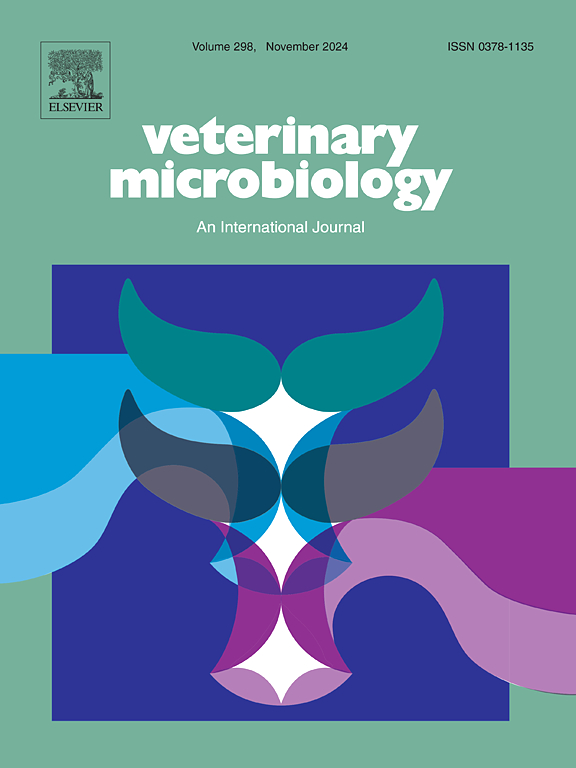表达H9N2禽流感病毒NS1蛋白的MDCK细胞株促进NS1基因截断病毒的复制
IF 2.7
2区 农林科学
Q3 MICROBIOLOGY
引用次数: 0
摘要
H9N2亚型禽流感病毒(AIV)仍然是对家禽业的主要威胁。我们之前开发的候选减毒活疫苗rTX-NS1 - 128(mut)显示出有希望的免疫原性,但相对于亲本rTX菌株,其截断的NS1基因减少了MDCK细胞的复制。在这项研究中,我们设计了一种MDCK衍生的细胞系(2G8D5)来增强干扰素敏感AIV候选株的复制。通过慢病毒转导,2G8D5组成性地表达全长NS1,从而抑制I型干扰素应答。rTX-NS1-128 (mut)在2G8D5细胞中的感染滴度高于标准MDCK细胞。在2G8D5的连续传代中,病毒保持遗传稳定,没有HA基因突变,也没有明显的TCID₅₀和EID₅₀变化。在无特定病原体(SPF)鸡中,2G8D5病毒诱导的血凝抑制(HI)滴度和IgY/IgA水平与SPF鸡胚中生长的病毒诱导的水平相当。细胞因子谱显示各组间IL-4、IL-5和IFN-γ表达相似。在挑战时,接种疫苗的鸡表现出减少的病毒脱落;每组只有两只鸡在攻毒后3天(d.p.c)脱落病毒。总之,这些发现突出了2G8D5作为生产rTX-NS1-128 (mut)的强大平台的潜力,并强调了其在开发针对H9亚型禽流感病毒的减毒活疫苗中的重要性。本文章由计算机程序翻译,如有差异,请以英文原文为准。
MDCK cell line expressing H9N2 avian influenza virus NS1 protein promotes replication of the NS1 gene truncation virus
H9N2 subtype avian influenza virus (AIV) remains a major threat to poultry industry. Our previously developed live-attenuated vaccine candidate rTX-NS1–128(mut) demonstrated promising immunogenicity, but its truncated NS1 gene reduced replication in MDCK cells relative to the parental rTX strain. In this study, we engineered an MDCK derived cell line (2G8D5) to enhance replication of interferon-sensitive AIV candidates. Using lentiviral transduction, 2G8D5 constitutively express the full-length NS1, thereby dampening type I interferon responses. rTX-NS1–128(mut) reached higher infectious titers in 2G8D5 than in standard MDCK cells. Over serial passages in 2G8D5, the virus remained genetically stable, with no HA gene mutations and no appreciable variation TCID₅₀ and EID₅₀. In specific-pathogen-free (SPF) chickens, virus produced in 2G8D5 elicited hemagglutination inhibition (HI) titers and IgY/IgA levels comparable to those induced by virus grown in SPF chicken embryo. Cytokine profiling showed similar IL-4, IL-5, and IFN-γ expression between groups. Upon challenge, vaccinated chickens exhibited reduced viral shedding; only two chickens per group shed virus at 3 days post-challenge (d.p.c.). In conclusion, these findings highlight the potential of the 2G8D5 as a robust platform for producing rTX-NS1–128(mut) and underscore its significance in the development of live attenuated vaccines against H9 subtype avian influenza virus.
求助全文
通过发布文献求助,成功后即可免费获取论文全文。
去求助
来源期刊

Veterinary microbiology
农林科学-兽医学
CiteScore
5.90
自引率
6.10%
发文量
221
审稿时长
52 days
期刊介绍:
Veterinary Microbiology is concerned with microbial (bacterial, fungal, viral) diseases of domesticated vertebrate animals (livestock, companion animals, fur-bearing animals, game, poultry, fish) that supply food, other useful products or companionship. In addition, Microbial diseases of wild animals living in captivity, or as members of the feral fauna will also be considered if the infections are of interest because of their interrelation with humans (zoonoses) and/or domestic animals. Studies of antimicrobial resistance are also included, provided that the results represent a substantial advance in knowledge. Authors are strongly encouraged to read - prior to submission - the Editorials (''Scope or cope'' and ''Scope or cope II'') published previously in the journal. The Editors reserve the right to suggest submission to another journal for those papers which they feel would be more appropriate for consideration by that journal.
Original research papers of high quality and novelty on aspects of control, host response, molecular biology, pathogenesis, prevention, and treatment of microbial diseases of animals are published. Papers dealing primarily with immunology, epidemiology, molecular biology and antiviral or microbial agents will only be considered if they demonstrate a clear impact on a disease. Papers focusing solely on diagnostic techniques (such as another PCR protocol or ELISA) will not be published - focus should be on a microorganism and not on a particular technique. Papers only reporting microbial sequences, transcriptomics data, or proteomics data will not be considered unless the results represent a substantial advance in knowledge.
Drug trial papers will be considered if they have general application or significance. Papers on the identification of microorganisms will also be considered, but detailed taxonomic studies do not fall within the scope of the journal. Case reports will not be published, unless they have general application or contain novel aspects. Papers of geographically limited interest, which repeat what had been established elsewhere will not be considered. The readership of the journal is global.
 求助内容:
求助内容: 应助结果提醒方式:
应助结果提醒方式:


